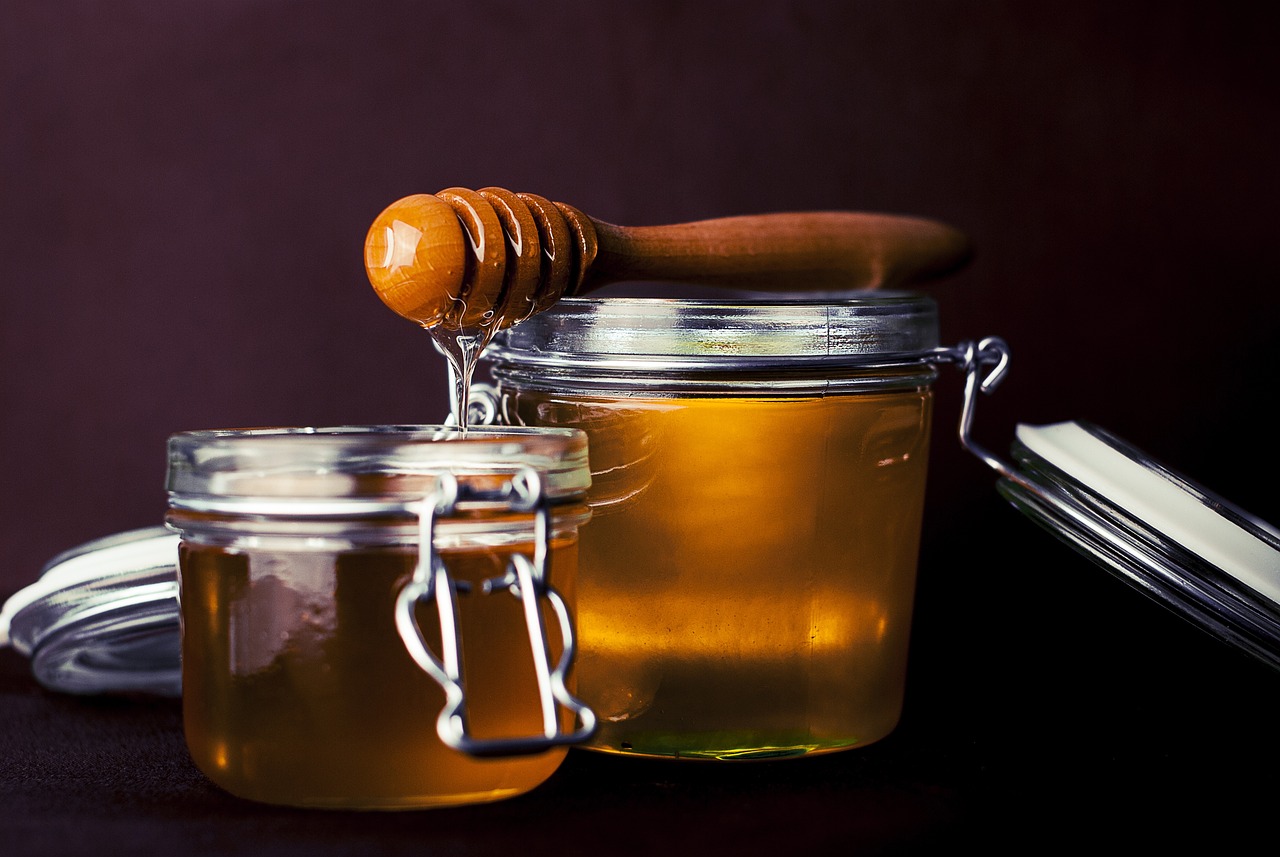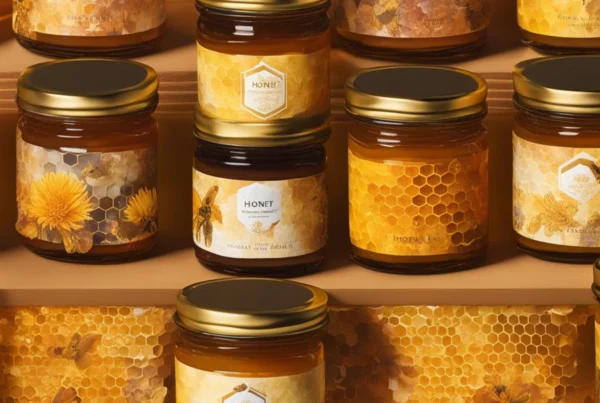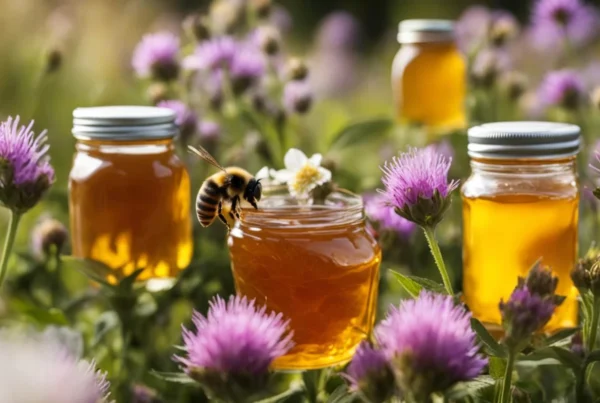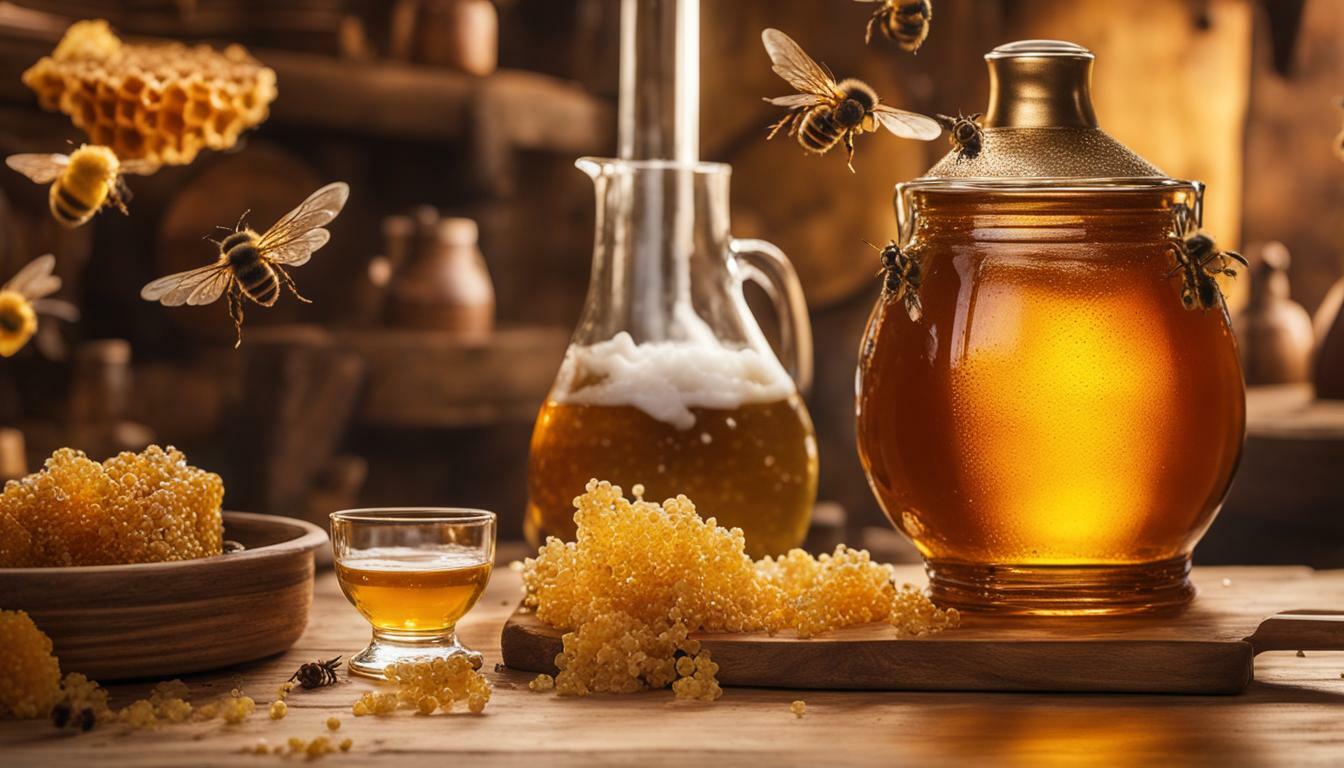
Welcome to the enchanting world of honey mead, a unique and ancient beverage that has delighted palates for centuries. Made with a combination of honey, water, and yeast, mead is sometimes referred to as honey wine or simply honey mead. In this section, we’ll explore the rich history of mead, its brewing process, and the various flavors available.
Key Takeaways:
- Honey mead is a type of alcohol made from a combination of honey, water, and yeast.
- Mead is sometimes referred to as honey wine or honey mead.
- In this section, we’ll explore the history, brewing process, and flavors of honey mead.
The History of Honey Mead: From Ancient Times to Modern Day
Since its discovery thousands of years ago, honey mead has been enjoyed by cultures around the world. Its origins can be traced back to ancient civilizations in Europe, Africa, and Asia, where it was considered a sacred drink with medicinal properties.
Traditional mead production involves fermenting honey with water and yeast, creating an alcoholic beverage with a sweet and complex flavor. Over time, various cultures developed their unique versions of mead, incorporating herbs, spices, and fruit juices to enhance its taste.
The Evolution of Mead Production
As civilizations expanded and trade routes were established, the popularity of mead spread. By the Middle Ages, mead was a staple in many European countries, with monasteries and royal courts brewing their unique versions.
However, with the rise of beer and wine production, mead began to decline in popularity. It wasn’t until the 20th century that mead experienced a revival, with modern breweries experimenting with different styles and flavors.
The Cultural Significance of Honey Mead
Mead holds a special place in many cultures, often associated with celebrations and rituals. In Norse mythology, mead was the drink of the gods, while in Africa, it was believed to have healing properties.
Today, mead is still a part of many cultural traditions, including the African-American celebration of Kwanzaa and Scandinavian Midsummer festivals. As a versatile beverage, mead continues to hold cultural significance in modern times.
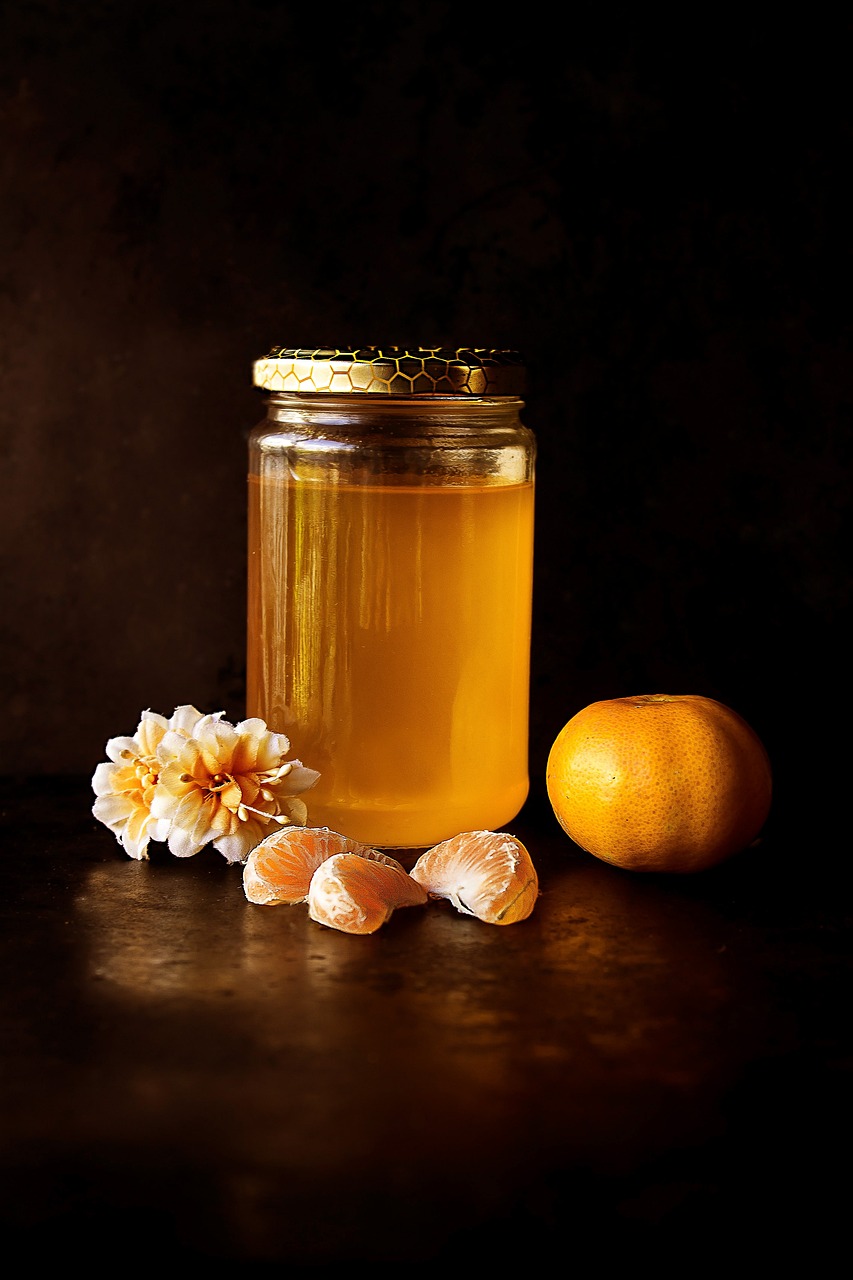 The Basics of Brewing Honey Mead at Home
The Basics of Brewing Honey Mead at Home
If you’re looking to create your own homemade mead, understanding the brewing process is key. Here are the basic steps:
- Choose Your Honey: Select a high-quality honey that suits your tastes and budget. Wildflower honey is a popular choice, but you can also experiment with different varieties for unique flavor combinations.
- Sanitize Equipment: Ensure all equipment including carboys, airlocks, siphons, and bottles are thoroughly sanitized to avoid contamination.
- Combine Honey and Water: Mix honey and boiled water at a ratio of 3:1 to create your honey mixture or “must”.
- Add Yeast: Add a yeast nutrient and the selected yeast strain to your honey mixture and cover with an airlock.
- Ferment: Allow the mixture to ferment for up to several weeks, depending on the strength and flavor desired.
- Bottle and Age: Once fermentation is complete, bottle the mead and store it for aging. Bottle conditioning can take several months to achieve the desired carbonation and flavor.
While these are the basic steps for creating mead, experimenting with different ingredients and techniques can lead to unique and delicious homemade recipes.
Basic Mead Recipe
| Ingredients | Amount |
|---|---|
| High-quality honey | 3 lbs |
| Boiled water | 1 gallon |
| Yeast nutrient | 1 tsp |
| Yeast (e.g. Lalvin D47) | 1 packet |
Combine honey and boiled water to create the honey mixture. Add the yeast nutrient and selected yeast strain, and cover with an airlock. Ferment for several weeks until complete. Bottle and age for several months before serving.
The Variety of Honey Mead Flavors
One of the most exciting aspects of honey mead is the wide range of flavors and varieties available. From traditional dry meads to fruity and spiced blends, there’s a honey mead flavor to suit every palate. The infusion of different ingredients and techniques used during the brewing process creates unique and delicious honey mead flavors.
Popular Honey Mead Flavors
Some of the most popular honey mead flavors include:
- Cyser: Made with honey and apples, cyser is a sweet and fruity mead.
- Metheglin: This spiced mead is made with a blend of honey and herbs like cloves, cinnamon, and nutmeg.
- Braggot: Braggot is a blend of honey mead and beer, typically made with hops and malt.
- Melomel: Made with honey and fruit, melomel is a sweet and tart mead with flavors like raspberry, strawberry, and blueberry.
- Sack: Sack meads are sweet and high in alcohol content, made with a high concentration of honey.
Creating Unique Honey Mead Flavors
The options for creating unique honey mead flavors are endless. Brewers often experiment with different combinations of herbs, fruits, and spices to create new and exciting flavors. Some popular ingredients used in honey mead brewing include:
| Ingredient | Flavor Profile |
|---|---|
| Ginger | Spicy and aromatic |
| Lavender | Floral and aromatic |
| Hops | Bitter and earthy |
| Cloves | Spicy and warm |
| Chili peppers | Spicy and hot |
By experimenting with different ingredients and techniques, honey mead brewers continue to push the boundaries and create innovative new flavors.
The Health Benefits of Honey Mead
Honey mead is not just a delicious beverage, but it also has potential health benefits. The natural properties of honey, one of the primary ingredients in mead, contribute to a healthy lifestyle when consumed in moderation.
Honey is known for its antimicrobial and anti-inflammatory properties, which can aid in wound healing and soothe sore throats. It is also rich in antioxidants, compounds that help protect the body against damaging free radicals.
When honey is fermented into mead, it may also offer additional health benefits. Research has shown that moderate consumption of alcoholic beverages, such as mead, can have positive effects on cardiovascular health, including reducing the risk of heart disease and stroke.
It is worth noting that excessive consumption of mead or any alcoholic beverage can have negative effects on health, and the benefits of mead should be enjoyed in moderation.
Pairing Honey Mead with Food: A Culinary Adventure
With its unique blend of sweet and tart flavors, honey mead can be paired with a variety of foods to enhance the taste and experience. If you’re looking for a new culinary adventure, consider these suggestions for pairing honey mead with different cuisines:
Cheeses and Charcuterie
Honey mead pairs well with rich and savory cheeses, such as brie, gouda, or blue cheese. It also complements salty meats like prosciutto or salami. The sweetness of the honey mead balances out the saltiness of these foods, creating a perfect flavor combination.
Seafood and Poultry
Try pairing honey mead with seafood or poultry dishes like roasted chicken or salmon. The subtle sweetness of the mead will complement the flavors of the poultry or fish, creating a well-rounded taste.
Spicy Dishes
If you’re a fan of spicy dishes, try pairing them with honey mead. The sweetness of the mead can help to cut through the heat and balance out the flavors. Consider pairing honey mead with Thai curries or spicy Szechuan dishes.
Desserts
The sweet and floral notes of honey mead make it the perfect complement to desserts. Pair it with fruit tarts, cheesecake, or chocolate truffles for a deliciously indulgent experience.
When pairing honey mead with food, keep in mind that it’s important to find a balance between the flavors. You don’t want the food to overpower the mead, but you also don’t want the mead to overpower the food. Experiment with different dishes and flavors to find the perfect pairing for your tastes.
Honey Mead Festivals and Events
For honey mead enthusiasts, there’s no better way to celebrate this beverage than attending a honey mead festival or event. These gatherings offer an opportunity to taste different varieties of mead wine, learn about mead production, and socialize with other mead lovers. Here are some of the most popular honey mead festivals and events in the United States:
| Festival/Event | Location | Date |
|---|---|---|
| Meadful Gathering | Bellingham, WA | May |
| Meadows of Dan Folk Festival | Meadows of Dan, VA | June |
| Meadville Renaissance Faire | Meadville, PA | September |
| Mead & Cider Fest | Seattle, WA | November |
These events offer a chance to taste mead wine from various meaderies and learn about the honey mead production process. Many also offer food, live music, and mead-making demonstrations.
Why Attend a Honey Mead Festival?
Attending a honey mead festival can be a unique and enjoyable experience for anyone interested in mead wine. Not only can you taste different varieties, but you can also learn about the cultural significance of mead production. These events often attract mead enthusiasts from all over the country, providing an opportunity to socialize and network with others who share a love for this ancient beverage.
- Sample different varieties of mead wine
- Learn about mead production from experts
- Attend mead-making demos
- Enjoy food and live music
- Network with mead enthusiasts
Whether you’re a seasoned mead drinker or a newcomer to the world of mead wine, attending a honey mead festival can be a fun and educational experience. Check out some of the events listed above and experience the unique tastes and aromas of honey mead for yourself.
Exploring Honey Mead Brands and Breweries
As the popularity of honey mead continues to rise, more and more brands and breweries are entering the market. Here are some top honey mead producers in the United States to explore:
| Brand/Brewery | Location | Specialty Flavors |
|---|---|---|
| Redstone Meadery | Boulder, CO | Black Raspberry Nectar, Juniper Mountain Berry |
| Moonlight Meadery | Londonderry, NH | Honey Apple, Desire, Kurt’s Apple Pie |
| Superstition Meadery | Prescott, AZ | Blueberry Spaceship Box, Peanut Butter Jelly Crime, Lagrimas de Oro |
These brands and breweries offer a wide variety of honey mead options, from traditional dry meads to fruit and spice-infused blends. Many also offer tasting rooms and tours, allowing you to sample their offerings and learn more about the brewing process.
The Benefits of Supporting Small-Batch Producers
Small-batch honey mead producers often take a more artisanal approach to brewing, using high-quality ingredients and experimenting with unique flavor combinations. By supporting these producers, you not only get to enjoy delicious and unique honey mead creations but also help sustain independent businesses and the local economy.
So whether you’re looking to explore new flavors or support small-batch producers, there are plenty of honey mead options to choose from. Branch out and discover the wide world of honey mead!
Honey Mead and Mead Wine: What’s the Difference?
Honey mead and mead wine are often used interchangeably. While they share similarities, there are also subtle differences between the two.
Traditionally, honey mead is a fermented beverage made with honey, water, and yeast. It is typically low in alcohol content and has a sweet taste. Mead wine, on the other hand, is a fortified wine made by adding honey to grape wine. This results in a higher alcohol content and a more complex flavor profile.
While honey mead is often considered a more rustic, homemade beverage, mead wine is often associated with sophistication and luxury. Mead wine can be aged for several years, while honey mead is typically consumed within a few months.
Despite their differences, both honey mead and mead wine offer a unique drinking experience and are worth exploring for their distinct flavors and aromas.
Tips for Storing and Serving Honey Mead
Honey mead is a unique and delicate beverage that requires proper storage and serving techniques to preserve its rich aromas and flavors. Follow these tips to ensure you savor every sip:
Storage:
- Store your mead in a cool, dark place, away from direct sunlight or heat sources. A basement or cellar is an ideal location for storage.
- Avoid storing mead in the refrigerator for extended periods as it can cause the honey to crystallize, compromising the flavor.
- If storing an open bottle of mead, seal it tightly with a cork or stopper to prevent air from entering the bottle.
Serving:
- Remove the bottle from storage and let it reach room temperature before serving, usually between 55-65°F. This will allow the flavors to fully develop.
- Pour mead into a glass with a wide bowl and narrow rim to enhance its aroma and taste. A glass designed for white wine or a tulip-shaped glass works well.
- When serving, pour mead gently to avoid disturbing the sediment at the bottom of the bottle.
- Serve mead with food that complements its flavors. Traditional pairings include cured meats, cheese, nuts, and fruit. Sweet meads pair well with desserts, while dry meads complement savory dishes.
Conclusion
Honey mead is truly a beverage with a rich history and a unique flavor profile. From its earliest beginnings to its resurgence in popularity today, honey mead has remained a beloved beverage for centuries. Whether you choose to explore homemade recipes or indulge in commercially brewed offerings, the world of honey mead is waiting to be discovered.
With its potential health benefits and versatility in pairing with food, honey mead is a true culinary adventure. From traditional, dry meads to fruity and spiced variations, there is a honey mead flavor to suit every palate.
Whether you are a seasoned mead enthusiast or a newcomer to the world of honey mead, we hope that this article has provided you with a deeper understanding and appreciation for this ancient elixir. So go forth and raise a glass of honey mead to toast to its fascinating history, delicious flavors, and future possibilities!
FAQ
Q: What is honey mead?
A: Honey mead is a type of alcoholic beverage made from fermenting a mixture of honey, water, and sometimes additional ingredients like fruits or spices. It is often referred to as honey wine.
Q: How long has honey mead been around?
A: Honey mead has a long history, dating back thousands of years. It is believed to be one of the oldest known fermented beverages, with evidence of its production found in ancient cultures across the world.
Q: Can I make honey mead at home?
A: Yes, you can make honey mead at home! There are various resources available, from recipes to brewing kits, that can guide you through the process. It’s a fun and rewarding hobby for those interested in exploring the world of mead.
Q: What are the different flavors of honey mead?
A: Honey mead comes in a wide range of flavors. Traditional meads tend to be dry and showcase the honey’s natural characteristics. However, there are also fruity meads, spiced meads, and even meads infused with herbs or botanicals.
Q: Are there any health benefits to drinking honey mead?
A: Honey mead contains the natural properties of honey, which has been associated with various health benefits. However, it’s important to enjoy honey mead in moderation and consult with a healthcare professional for personalized advice.
Q: What food pairs well with honey mead?
A: Honey mead can be paired with a variety of foods. It complements cheese and charcuterie boards, grilled meats, roasted vegetables, and even desserts like fruit tarts or chocolate. The possibilities for culinary adventures are endless!
Q: Are there any honey mead festivals or events?
A: Yes, there are honey mead festivals and events where enthusiasts gather to celebrate this unique beverage. These events often feature tastings, educational sessions, and opportunities to connect with mead producers and fellow mead lovers.
Q: Where can I find honey mead brands and breweries?
A: Honey mead brands and breweries can be found across the United States. Many have tasting rooms where you can sample their offerings, and some even offer online sales or distribution to local retailers. Check their websites or local mead directories for more information.
Q: What is the difference between honey mead and mead wine?
A: Honey mead and mead wine are terms often used interchangeably. However, mead wine typically refers to mead that has been aged or has a higher alcohol content, while honey mead can encompass a broader range of styles and flavors.
Q: How should I store and serve honey mead?
A: To maintain the quality of honey mead, store it in a cool and dark place, away from direct sunlight. When serving, chill it slightly to enhance the flavors, and use appropriate glassware such as wine glasses or goblets.

